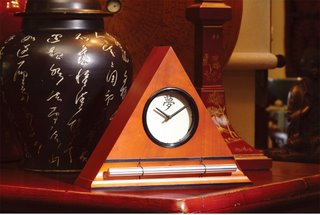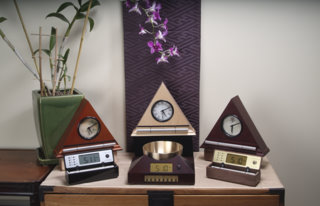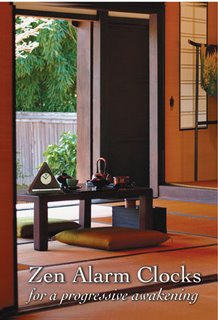|
 Secure Site
Secure Site
|
 |
 Sanmonji, Sleeping Cat 1992, woodblock print Sleep is an essential bodily function, like eating and breathing. But more and more, we minimize its importance, and the health effects can be devastating. Besides affecting how we feel and function day to day, a chronic lack of sleep have harmful effects on our emotional and spiritual well-being.
Besides allowing our bodies and brains to refuel, sleep allows for our souls to recharge.
Here are two relaxation techniques to use as you wind-down in the evening:
Use a mind-body technique. Doing a bedtime relaxation exercise, such as the following, can help you fall asleep or get better, deeper sleep. Paced breathing, inhale through your nose for a count of four. Hold for a count of seven. Exhale through your mouth for a count of eight. As you breathe, rest the tip of your tongue on the ridge behind your front teeth. When you exhale, it should create a shooshing sound. Repeat four times.
Mental Muscle Relaxation
Lying down or sitting comfortably, close your eyes and take a few deep breaths. Starting at the top of your head, notice whether there’s tension in your scalp and forehead. If there is, let it go. Progress all the way down your body, assessing each muscle group and mentally releasing any tension.
Our Zen Timepiece’s acoustic 6-inch brass bowl-gong clock is the world’s ultimate alarm clock, practice timer, and “mindfulness bell.” It awaken you with the beautiful tones of a singing-bowl, used by many sound therapist.
It fills your environment with beautifully complex tones whenever it strikes. In the morning, its exquisite sounds summon your consciousness into awakening with a series of subtle gongs that provide an elegant beginning to your day. Once you experience the Zen Timepiece‘s progressive awakening, you’ll never want to wake up any other way. It also serves as the perfect meditation timer. Available in 5 wood styles, including bamboo. Remember to set your Zen Alarm Clock with the 10 minute programmed chime sequence to awken you in the morning relaxed and refreshed.
adapted from Body + Soul, November 2009 by Tracy Gaudet, M.D.
 Singing Bowl Alarm Clock with Natural Sounds to Awaken You Now & Zen – The Gradual Alarm Clock Store
1638 Pearl Street
Boulder, CO 80302
Posted in Japanese Inspired Zen Clocks, Natural Awakening, Now & Zen Alarm Clocks, Progressive Awakening, Sleep Habits
 Change Your Alarm Clock - Choose the Gentle Chime Clock from Now & Zen Gradual awakening with natural tones helps reduce morning grogginess
Rather than an artificial recorded sound played through a speaker, the Zen Clock features an alloy chime bar similar to a wind chime. When the clock’s alarm is triggered, its chime produces a long-resonating, beautiful acoustic tone reminiscent of a temple gong. Then, as the ring tone gradually fades away, the clock remains silent until it automatically strikes again three minutes later. The frequency of the chime strikes gradually increase over ten-minutes, eventually striking every five seconds, so they are guaranteed to wake up even the heaviest sleeper. This gentle, ten-minute “progressive awakening” leaves users feeling less groggy, and even helps with dream recall.
 change your alarm clock, change your life Now & Zen – The Gradual Alarm
Clock Store
1638 Pearl Street
Boulder, CO 80302
(800) 779-6383
Posted in Bamboo Chime Clocks
 trouble waking up? Worry No More…
Boulder, Colorado—an innovative company has taken one of life’s most unpleasant experiences (being startled awake by your alarm clock early Monday morning), and transformed it into something to actually look forward to.
“The Zen Alarm Clock,” uses soothing acoustic chimes that awaken users gently and gradually, making waking up a real pleasure. Rather than an artificial recorded sound played through a speaker, the Zen Clock features an alloy chime bar similar to a wind chime. When the clock’s alarm is triggered, its chime produces a long-resonating, beautiful acoustic tone reminiscent of a temple gong. Then, as the ring tone gradually fades away, the clock remains silent until it automatically strikes again three minutes later. The frequency of the chime strikes gradually increase over ten-minutes, eventually striking every five seconds, so they are guaranteed to wake up even the heaviest sleeper. This gentle, ten-minute “progressive awakening” leaves users feeling less groggy, and even helps with dream recall.
 waking up happy Now & Zen’s Chime Alarm Clock Store
1638 Pearl Street
Boulder, CO 80302
(800) 779-6383
 Peaceful Wake Up Chime Alarm Clocks
Posted in Natural Awakening, sleep, Sleep Habits
 natural acoustic alarm clock The luxurious awakening provided by the Zen Alarm Clock is part of the growing preference for things natural—natural foods, natural fibers, and now, natural acoustic sounds. Like organic tomatoes in your salad, the organic sounds of the Zen Alarm Clock’s sweet acoustic chimes are truly a gourmet experience. And those who like organic food may also appreciate how the Zen Clock can be used as an aesthetically sophisticated timer for practices such as yoga or meditation.
 Pink Orchid Now & Zen – The Gradual
Clock Store
1638 Pearl St.
Boulder, CO 80302
(800) 779-6383
Posted in Bamboo Chime Clocks
 zen stones It’s hard to believe in the sages’ promise of higher consciousness—until that breakthrough moment happens to you. Here, a report from those who’ve been there.
By Deborah Willoughby
Edgar Mitchell was on his way home. Two days before he had been on the moon collecting rock samples, and now he was speeding through space accompanied by two other astronauts. Gazing at Earth and the stars through the tiny window of Apollo 14, he was engulfed by a new and startling sensation: an all-encompassing aura of universal connectedness. All sense of boundaries dissolved, and he saw that he, his companions, and everyone and everything on the shining planet in the window were held in a luminous web of consciousness. What is more, he knew with absolute certainty that, as he put it later, “the glittering cosmos itself was in some way conscious.”
Mitchell was experiencing a spontaneous glimpse of what the sages of the yoga tradition call higher consciousness—a direct, intuitive experience of the infinite field of awareness that underlies and pervades the entire universe. When this experience is fully expanded, different traditions give it different names—samadhi, nirvana, enlightenment, turiya, shunyata, Brahman, Christ Consciousness, Absolute Truth, Atman, God, the Self, Supreme Consciousness—but whatever they call it, spiritual masters tell us that this experience of an all-pervasive consciousness reveals the truth about ourselves and the world we inhabit: it is all One. There is no division, no multiplicity, no separation. Everything—the astonishing variety of living beings; nature’s myriad shapes, textures, and forms; the sun, the stars, the clouds, and the wind in the trees—all of it is a manifestation of an indivisible field of Consciousness. The goal of human life, the sages tell us, is to meet that Consciousness within ourselves and to know ourselves as That.
The sages also tell us all of our problems, indeed all of the world’s problems, can be traced to a single source: we misunderstand the nature of reality. Hypnotized by outward appearances, we misread the world around us. We see multiplicity instead of unity, separation instead of wholeness. Because we don’t understand that all beings share one life force, one consciousness, we blunder about, damaging ourselves by damaging others. It all boils down to an epic misunderstanding—and leaves us looking for fulfillment in all the wrong places.
 stillness practice “We are all looking for the peace and freedom and security of perfect union with the Atman,” Swami Prabhavananda and Christopher Isherwood write in How to Know God, their classic commentary on theYoga Sutra. “We all long desperately to be happy. But ignorance misdirects us. It assures us that the Atman cannot really be within us, that we are nothing but individuals, separate egos…. We seek security in the accumulation of possessions, or by the destruction of our imagined enemies. We seek happiness through sense gratification, through every kind of vanity and self-delusion. We seek peace through the intoxication of various drugs. And in all these activities we display an energy of heroic proportions…. It is tragically misdirected energy. With less effort, we might easily have found union with the Atman, had we not been misled by our ignorance.”
The good news is that this veil of ignorance is readily lifted. Experiencing Consciousness is simplicity itself, the sages tell us—after all, it is our own true nature. As the 14th-century master, Vidyaranya Yati put it, “You are whatever you know yourself to be. This is a simple law. Brahmavit Brahmaiva bhavati. The knower of Brahman becomes Brahman. The moment you know that you are inseparable from Universal Consciousness, you become that Universal Consciousness.” Five centuries later, Swami Vivekananda put it another way: “The moment I have realized God sitting in the temple of every human body, the moment I stand in reverence before every human being and see God in him—that moment I am free from bondage, everything that binds vanishes, and I am free.” My own teacher, Swami Rama, had another way of expressing it: “It’s as simple as flipping a light switch. Suppose this room is kept dark for one hundred years. How long will it take to light this room? One second.”
 sousaku hanga woodblock print by Yoshida Toshi (ca 1970's Swamiji’s spiritual heir, Pandit Rajmani Tigunait, takes the same view, as I discovered one winter morning while complaining to him about feeling spiritually stuck. Panditji leaned forward, took my face in his hands, and turned my head a few degrees. “It’s right there,” he said forcefully. “There! Adjust your gaze a fraction, you’ll see it. Everything is Consciousness. Everything!”
Most of us don’t see it—at least not at first and not easily. It’s like an Escher print. First you see one thing—black ducks flying across a white sky—and then your perspective shifts a hair and you are looking at a picture of white fish swimming through black water. Once you’ve seen the fish, you see them every time you glance at the print. Spiritual teachers say that the unity underlying the apparent diversity is like that—palpable, obvious, and undeniable. The trick is to learn to refocus our gaze.
To do that, it helps to know what we’re attempting to see. The image on the opposite page seems unremarkable, but if you know it’s a stereogram, you will study it more closely. Look at it long enough and in the right way, and the bees recede into the distance and the hummingbirds float across the page in three dimensional rows. That’s what meditation is, looking within from the right angle often enough and long enough for the illusion of separateness to drop away and Reality to snap into focus.
Swami Rama was fond of saying, “It is easy to meet that Infinity within you—to attain that awareness, you just have to be silent.” It’s easy. Sit down, close your eyes, draw your attention inward, quiet your mind, and you are “There”—at least in theory. For most of us, the experience of meditation is quite different. We sit down, close our eyes, draw our attention inward, and come face-to-face with a noisy, scattered, unruly mind. We mean to focus on the mantra but find ourselves composing the grocery list instead; the mind jumps to the day ahead or the upcoming weekend, the vacation we’d like to take or the one we just had; it busies itself sorting through the latest dustup at the office, skitters through the mess in Iraq, then slides off into what we’re getting the kids for Christmas. Silence eludes us—and so does an awareness of Infinity.
 stillness It’s the classic chicken-and-egg dilemma. The experience of Oneness is the fruit of a disciplined meditation practice. But a disciplined meditation practice unfolds from a taste of that fruit. Once it’s had a taste of Unitary Consciousness, the mind is drawn to it like a bee to a blossom and is no longer so easily distracted when we sit for meditation. But without that initial taste, we’re at a bit of a loss. We believe—or would like to believe—what the scriptures, the sages, and our teachers tell us: that we are inextricably entwined in a nourishing web of Consciousness. But our day-to-day experience is quite different—we’ve become accustomed to a vision of duality, trained to see ourselves as separate from each other and from the natural world, and so that’s what we see. We’re seeking a deeper, richer vision of ourselves and our world but we don’t quite know how to bring it into focus.
It came into focus for Edgar Mitchell when he was 240,000 miles out from Earth, seeing his home planet cradled in a nest of stars. His work was essentially finished, the moonwalk had been a success, and he had time to reflect on the mission, time to “absorb the magnificence and beauty of the whole process.” As he explained it in an interview with The Monthly Aspectarian, as a result of “seeing Earth as it is in the heavens, the precise experience for me was to recognize that the molecules of my body and the molecules of the spacecraft—I had studied stellar formation and knew how the furnaces of the stars and galaxies created our chemical elements—I suddenly realized that those were my molecules being manufactured and prototyped in those stars. Instead of being an intellectual experience, it became a very deep, personal, emotional one, a knowing. It was such a profound experience that I went into a different realm of seeing things.”
 Meditation on the mountain I had a similar experience during a pilgrimage to Kedarnath, a shrine high in the Himalayas. Much less arduous than a journey to the moon, pilgrimage is a time-honored way of cultivating an expanded vision. Step away from the demands and distractions of daily life, leave the familiar behind, and go—deliberately and with determination—to a place known for its spiritual energy. Pandit Rajmani explains it this way: “If you are seeking a certain kind of knowledge and experience, go to a place where it is readily available. If you are seeking knowledge and experience in technology, go to MIT. If you are seeking an experience of the inner dimension of your life, go to a place charged with spiritual energy. When you go to such places with the intention of connecting yourself to the flow of all-pervading Consciousness, your individual consciousness is expanded and transformed by the collective consciousness which permeates that place.”
Mecca, Jerusalem, Assisi, Banaras, Allahabad, Mount Kailash, Mount Fuji, and Mount Kilimanjaro are among the places Consciousness has shaped in Her own image. Here at these and other shrines, the perceived barrier between the physical realm and the subtle realm thins to the point of transparency, and the all-embracing matrix of Consciousness shines through.
I caught a glimpse of it last summer in the Himalayas. From the moment I began the nine-mile climb from the village of Gaurikund to Kedarnath, I was flooded with joy. Everything was perfect—sunlight on thickly wooded hillsides, snowcapped peaks framed by impossibly steep gorges, waterfalls spilling down at every turn, a chilly afternoon rain, the blister on my right heel, a trail that got rougher and steeper as the day wore on, the clammy guesthouse, even the cold-water-only shower. During the two days we stayed on the Kedarnath plateau and through the long walk back to Gaurikund, perfection reigned.
Nothing I did, nothing anyone around me did, could dislodge the all-encompassing beatitude. On the trek back, I deliberately brought things to mind that had been troubling me before I set foot on the trail—my mother’s slide into dementia, a financial snafu, a friend’s duplicity—but they had lost their sting. Everything I knew, remembered, or could imagine was supported and nourished by a munificent web of Consciousness.
For three days, I saw it and felt it. The feeling has faded, but the memory remains. And it is that memory that pulls me into meditation practice, erasing much of the tendency to distraction. My mind settles and moves toward silence more readily now. It hasn’t become as easy as flipping a switch—not by a long shot—but having walked in the light, however briefly, I have come to understand why Swami Vivekananda said: “We put our hands over our eyes and weep that it is dark.”
Deborah Willoughby is the founding editor of Yoga International.
 Yoga and Mediation Timers Now & Zen
1638 Pearl St.
Boulder, CO 80302
(800) 779-6383
Posted in Meditation Timers, Meditation Tools, mindfulness practice, Natural Awakening, nature
 Sweetest Sounding Alarm Clocks with Persistent Singing Bowl Chime Chime Zen Alarm Clocks with Tibetan-Singing Bowl deliver the Sweetest, Most Persistent Sounds that are Unique and Acoustic
What makes this gentle awakening experience so exquisite is the sound of the natural acoustic chime, which has been tuned to produce the same tones as the tuning forks used by musical therapists. According to the product’s inventor, Steve McIntosh, “once you experience this way of being gradually awakened with beautiful acoustic tones, no other alarm clock will ever do.”
 Elegant Women. Courtesy of the Japan Ukiyo-e Museum Now & Zen – The
Gradual Chime Alarm
Clock Store
1638 Pearl Street
Boulder, CO 80302
(800) 779-6383
Posted in Chime Alarm Clocks, Natural Awakening, nature, Now & Zen Alarm Clocks, wake up alarm clock
 Just Say No to a Snooze Button, use a Zen Clock Just Say No to a Snooze Button
Most modern alarm clocks include a “snooze button” mechanism which allows the user to go back to sleep for a brief period after the initial alarm.
While this may make it easier for some people to “face the day,” here at Now & Zen we feel the whole concept of a snooze button is “all wrong.”
People want snooze buttons because they want to awaken gradually. And this is only natural because just as our bodies fall asleep gradually, our bodies also want to wake up gradually. However, with a regular, snooze button-equipped alarm clock the user is initially “startled awake” by the alarm, and then continually startled awake with each press of the snooze button. This is not the way to treat your body because it creates a kind of merry-go-round of multiple “rude awakenings.”
As an alternative we recommend using our Zen Alarm Clock, which wakes users gradually with a built-in 10 minute progression of gradually increasing acoustic chimes. It really is a better way to get up in the morning.
Zen Alarm Clocks make waking up a beautiful experience. And once you experience the Zen Clock’s gradual 10 minute chime progression, you will never want to wake up any other way again.
 Zen Clocks are an Alternative to Snooze Button Clocks that Shorten Your Life! Now & Zen
1638 Pearl Street
Boulder, CO 80302
(800) 779-6383
Posted in Natural Awakening, sleep, Sleep Habits, wake up alarm clock
 Zen Clocks have a built in Snooze...no buttons! The Walnut Digital Zen Clock’s long-resonating Tibetan bell-like chime makes waking up a beautiful experience – its progressive chimes begin your day with grace. It has a built-in snooze feature so you don’t have to keep pressing the button!
When the clock’s alarm is triggered, the acoustic chime bar is struck just once … 3-1/2 minutes later it strikes again … chime strikes become more frequent over 10 minutes … eventually striking every 5 seconds until shut off. As they become more frequent, the gentle chimes will always wake you up – your body really doesn’t need to be awakened harshly, with a Zen Clock you’re awakened more gradually and thus more naturally. Unlike artificial recorded sounds coming out of a tiny speaker in a plastic box, natural acoustic sounds transform your bedroom or office environment.
 Zen Clocks wake up gradually without a Snooze button Now & Zen Headquarter Store
1638 Pearl Street
Boulder, CO 80302
(800) 779-6383
Posted in Bamboo Chime Clocks
 Soothing Bamboo Clocks Boulder Colorado-based Now & Zen, Inc., maker of the world famous Zen Alarm Clock®, announces the launch of a new line of bamboo Zen Clocks.
Now & Zen introduced its original Zen Alarm Clock in 1996, but according to company founder and president, Steve McIntosh, these bamboo clocks are the most beautiful of all their designs. “I’m really proud of the form, function, and sustainability profile of our new bamboo Zen Alarm Clock, it’s our greenest product yet,” said McIntosh. The bamboo Zen Clock is available in four different dial face choices, with each dial silkscreened directly on bamboo veneer for an integrated, natural look. The new bamboo dial faces include one with contemporary numbers, one with simple modern lines, one with the Japanese character for “dream,” and a “bamboo leaf and stalk motif” inspired by Chinese ink painting.
The wood used in all Now & Zen products is sustainably grown on tree farms, and the company operates according to a strict policy of environmental sustainability for all its operations. However, the introduction of the company’s bamboo line sets a new standard for sustainability. Bamboo, which is a species of grass, is a very “green” material for making clock bodies. Compared to a hardwood forest the same size, bamboo produces 30% more oxygen and 20 times the biomass yield. Bamboo can be harvested annually after the first 5 to 7 years without replanting, compared to 25 to 50 years for trees, which then need to be replanted in bare soil. Moreover, Bamboo is the fastest growing woody plant on the planet, and it’s qualities of oxygen production, carbon sequestering, and water and soil retention make it one of the world’s most sustainable commodities as well.
 Bamboo canes growing in the wild Now & Zen Headquarter Store
1638 Pearl Street
Boulder, CO 80302
(800) 779-6383
Posted in Bamboo Chime Clocks
 Chartres Cathedral, France
Eastern and Western Meditation Traditions: Both Cultures Use Bells and Chimes
Bells and chimes are used in both Eastern and Western meditation traditions. In the Christian monastic tradition, the ringing of the bell during meditation reminds the practitioners to return to the object of worship.
 Zen Monks
Similarly, Zen monks have used gongs and “mindfulness chimes” to begin their meditations and during meditation to bring them out of their mental processes back to the stillpoint of tranquility.
The use of metal alloy bowls for devotional purposes can be traced back to the beginnings of metallurgy in China prior to 1,000 B.C. The bowl that comes with our Zen Timepiece is modeled after a Japanese “rin gong,” or Keisu, that is periodically struck with a stick to punctuate sutra-reading in Buddhist temples.
The Himalayan peoples have been using metal bowls in their rituals and as offerings to Deities since at least 560 B.C. These hand-hammered Himalayan alloy bowls have come to be known as “Tibetan Singing Bowls” because of the unique way they are sounded by rubbing a mallet over the rim so as to produce harmonic resonances and overtones. Although the bowl that comes with our Zen Timepiece is not technically a Tibetan Singing Bowl, it will produce harmonic effects if a mallet or striking stick is rubbed around its edge in a circular motion.
 Bowl-gong Clock has a long-resonating chime sound The bowl that comes with the Zen Timepiece is made from the following five metals: copper, zinc, lead, iron, and tin. It has been formed using the same forging techniques that have been used in Asia for two thousand years. Unlike hand-hammered Himalayan-style bowls, our Zen Timepiece’s rin gong bowl is made using methods which first appeared in Japan in the first century. Following these traditions, our bowl’s long-resonating tone has been carefully selected to bring beauty and harmony to your environment.
Now & Zen – The Gradual Alarm Clock Store
1638 Pearl Street
Boulder, CO 80302
(800) 779-6383
Posted in Chime Alarm Clocks, Japanese Inspired Zen Clocks, Meditation Timers, Meditation Tools, Now & Zen Alarm Clocks, Truth, zen monks, Zen Timepiece by Now & Zen, Zen Timers
|
|
|
|